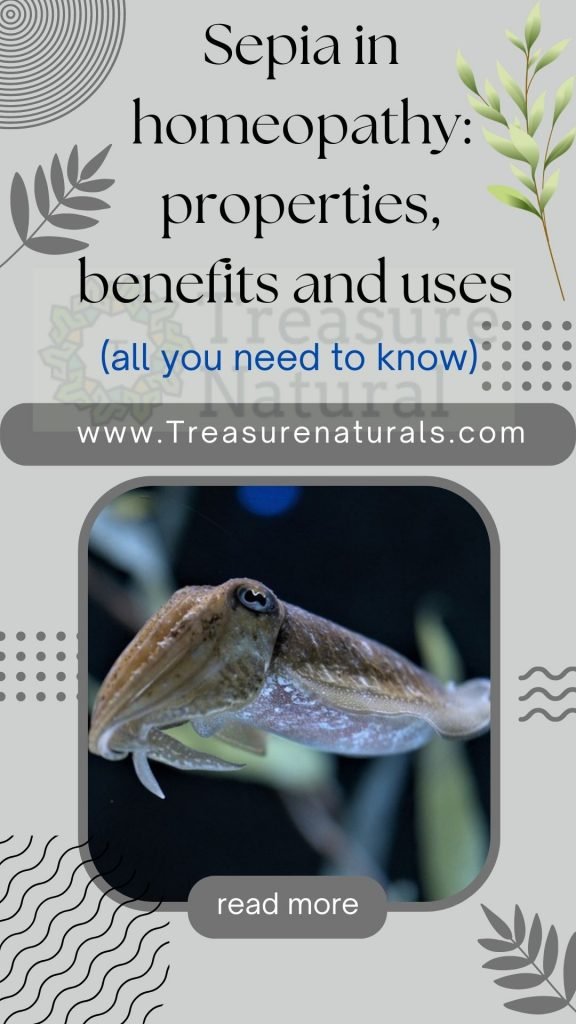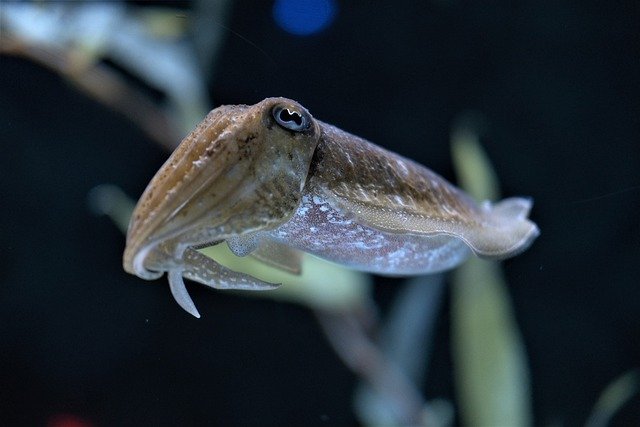
The homeopathic remedy Sepia comes from dried cuttlefish ink. This remedy is used in Homeopathy to solve problems related to hormones, digestion, urinary tract, anxiety, depression and migraine. We are faced with a substance that is definitely useful for women, especially during pregnancy, menopause or in case of menstrual pain.
Cuttlefish and its ink
The cuttlefish is a marine cephalopod mollusc widespread in every sea and in every ocean and that lives in the seabed. In particular, those of the Mediterranean Sea and the Atlantic Ocean belong to the species Sepia officinalis.
This mollusk can be of different sizes depending on the habitat it colonizes, has a varied color (gray-yellow, red, orange, brown, blue) and changes in such a way that it can camouflage with the seabed.
Its head is massive with eight arms of equal length equipped with suckers, which hide in the center a beak and two long retractable appendages equipped with suckers only at the apex. Its body contains the characteristic ink bag (located between the gills) that the animal emits into the water to escape its predators.
Cuttlefish ink contains different chemicals in different concentrations depending on the species to which it belongs. The main components are: melanin (pigment) and mucus, but tyrosinase (enzyme), dopamine (neurotransmitter), L-Dopa or Levodopa (intermediate in dopamine biosynthesis) can also be found, small amounts of amino acids (primary structural units of proteins) and mucins (glycoproteins) and from a chemical point of view four mineral salts: calcium carbonate, magnesium carbonate, sodium sulfate and sodium chloride.
Uses of cuttlefish ink
The famous “squid ink” is a liquid with a blackish-brown color due to the presence of melanin, which is its main constituent.
In the past it was used as an ink and in painting, but also in the medical field: Hippocrates prescribed cuttlefish in gynecological and obstetric diseases while Dioscorides and Pliny advised it in case of leucorrhoea, calculosis, bladder catarrhs and alopecia.
Today, however, it is mostly used in the kitchen as a condiment for pasta dishes. Squid ink is widely used in Sicilian cuisine, but it is also included in other regional cuisines (for example in Venetian cuisine and Tuscan cuisine with squid ink risotto) and, outside national borders, also in Catalonia (arròz negro) and Croatia (crni riżot). Its taste is not strongly marked: it has a slight taste of the sea, an iodized scent despite being particularly savory. Unequivocally stains the hands and teeth, but just wash with neutral soap and the color disappears easily.
Sepia: homeopathic remedy
The homeopathic remedy Sepia is obtained by shredding the cuttlefish ink, previously dried and then diluted / dynamized in hydroalcoholic solution according to the classic procedures. The realization in Homeopathy of the Sepia remedy therefore takes place through the use of materials of animal derivation, although the animal itself is not used directly as it happens in the preparation of the remedy Apis mellifica.
Sepia is one of the main polycris of Homeopathy and its constitution is phospho-fluoric with bilious-nervous temperament. Its action is particularly effective on:
- central nervous system
- general status
- venous circulation
- elastic fabric
- liver
- skin
The use of Sepia is indicated in the treatment of the following disorders:
- respiratory system: dry cough, laryngitis, hoarseness, chronic phlegm and dyspnea;
- cardiovascular system: problems with varicose veins, nosebleeds, rapid heartbeat during digestion, congestion in the head, palpitation and weakness, feeling of heaviness in the legs;
- nervous system: nervous breakdown, irritation, hysteria, neuralgia, poor memory performance, morning dizziness when getting up, headaches that improve by lying on the affected side, odontalgia. In addition, the healing properties of this homeopathic solution can also be used in the treatment of stye and chalazion;
- digestive system: nausea and vomiting in the period of pregnancy, dyspepsia, gastritis, hemorrhoids, enteritis;
- treatment of the liver in the presence of liver disease, liver failure and jaundice; the organ may be enlarged and sore;
- urinary system: dark and foul-smelling urine with frequent stimulus to urination, irritable bladder, pyelonephritis, incontinence and pollakiuria;
- genital apparatus, especially female: gonorrhea, dysmenorrhea, leucorrhoea, amenorrhea, menstrual disorders of the climacteric, irregularities in the menstrual cycle, uterine prolapse, low libido (also treatable in men) and constant pain even during the sexual act. For men it is used to treat blenorrhagia, periods of excitement with leakage of prostate fluid, phimosis and psychophysical fatigue after intercourse;
- skin: dandruff, chronic rashes, herpes, eczema, ringworm, warts in the genitals, seborrhea, dry rashes with a tendency to bleeding, ringworm and psoriasis;
- joint or muscle pain involving mainly the limbs, rheumatism with the presence of swelling, inflammation of the nerve.
Its synergies are: Natrum muriaticum, Nux vomica and Phosphorus. Its antidotes (but which help its action) are Aconitum napellus, Antimonium crudum, Antimonium tartaricum and Rhus toxicodendron. Finally, its incompatible are Bryonia, Lachesis, Pulsatilla.
Sepia: constitutional type

In Homeopathy the remedies act on certain categories of people rather than on others; often the homeopathic remedy and the type of person take on the same definition. This also concerns Sepia which in Homeopathy is used to treat all pathologies related to an apathetic personality type.
It is a category of people who, like the cuttlefish, tend to spend their lives in solitude. Their existence is characterized by an underlying pessimism and above all by the nervousness that often distances them from others, preventing them from developing a social life.
The subject Sepia is an intoxicated; its intoxication is slow and deep and can have various causes that are mainly attributable to a generally tuberculous diathesis, with portal, hepatic and urinary congestion disorders.
Below are the main clinical features of the Sepia type and its modalities:
Psychic symptoms
Apathy and indifference; desire to be alone; pessimism; tendency to crying; tendency to suicide; anger in the stenic phase.
General symptoms
Flushing; sense of fainting in church; weight in the lower abdomen; sense of rectal weight; emptiness of the stomach at 11 am; sensitivity to cold; ptosis; greenish-yellow secretions.
Local symptoms
- skin: yellowish brown spots; vesicular rashes in the genitals; warts, hardening
- head: migraine especially during the cycle; eyelid ptosis
- digestive system: sore and enlarged liver; dyspepsia; anorexia of smokers; constipation; dairy diarrhea; haemorrhoids
- urogenital apparatus: turbid urine; atonic uterus; abortive tendency, poor menstruation, frigidity; leukorrhoea
- locomotor system: lumbosacral pains; tendency to crooks
Mode:
- aggravations: cold, humid heat, consolation, menopause, pregnancy, kneeling, 10-11 am, milk
- improvements: movement
- laterality: left
- aversion: salt, milk, meat, fats
- desire: vinegar






